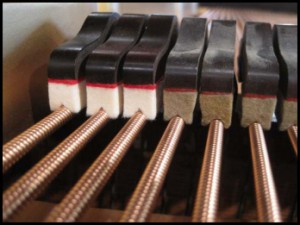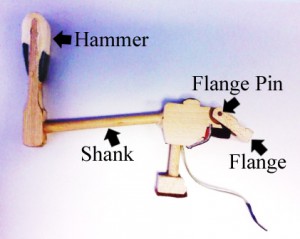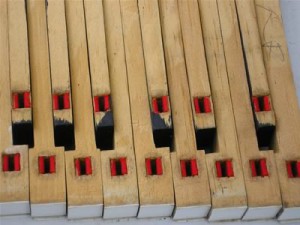I’ve heard a lot of my customers refer to “the felts” in their piano. I’m never exactly sure what part of the piano they are thinking of and usually after a little more conversation, it turns out they aren’t exactly sure either. What are “the felts”?
There is actually a lot of felt throughout the action of a piano, which is what leads to the confusion. It’s used in three primary ways:
First, and most importantly, the hammers are made of hard, packed felt. The hammers produce the tone, so their quality and condition are very important in how your piano sounds. As the hammers strike the strings thousands of times over the life of the piano, the felt wears off the hammer and the hammer changes shape, becoming flat instead of round at the tip. These felt hammers need to be re-shaped several times over the pianos lifetime to maintain good tone. You can read more about reshaping hammers here.
The second felt part in a piano is the damper. The dampers keep the string quiet when you want it quiet. Each note (the lower 60+ notes at least) has a felt damper that is pressed against the string to stop vibrations until you play the key. As you play the key, the hammer launches forward to hit the string and the damper lifts at the same time to let the string actually sound. As you let go of the key, the damper drops and quiets the string again.
Dampers are made of soft and “fluffy” felt compared to the hard, packed felt of the hammers. The dampers don’t wear our nearly as fast as the hammers, but they can get hard and crusty if they are exposed to damp conditions. Then the dampers will make vibrate against the string and make an unpleasant buzzing noise when they break contact or come back into contact with the string.
The hammers are made of hard felt, the dampers are made of soft felt and the “bushings” are made of felt cloth strips. There are lots of moving parts inside a piano and the felt bushings help many of the parts move easily and noiselessly. There are two felt bushings inside each key that help the wooden key stay in the correct place, and help it move up and down without rattling against the metal pins that hold it in place. There are tiny felt bushings in the “hinge” mechanisms in all the hammers and whippens. Thin but dense felt is put between wood and metal parts so parts can move, but be stable and quiet.
There are also tiny pieces of felt below the keys to keep the key at the right height and regulate how deeply the key can be pressed down. I just looked through all the pieces on my upright piano action model and there are generally 25 pieces of felt for each note. That’s nearly 2,200 pieces of felt in one upright piano action! All of these pieces of felt will wear out over time. When the key bushings wear, the key will start wobbling and wiggling instead of moving straight up and down. Sometimes they will even click. The flange bushings will usually get tight around the metal pin rather than loose. Then the felt has to be treated with chemicals, or eased by hand to make the hammer or whippin move freely again.
So, to recap, “the felts” is not a very useful term. When customers use the phrase, I usually assume they are talking about either the hammers or dampers because those are most obvious. But since there are so many felt parts inside a piano, it’s helpful to be more specific.






